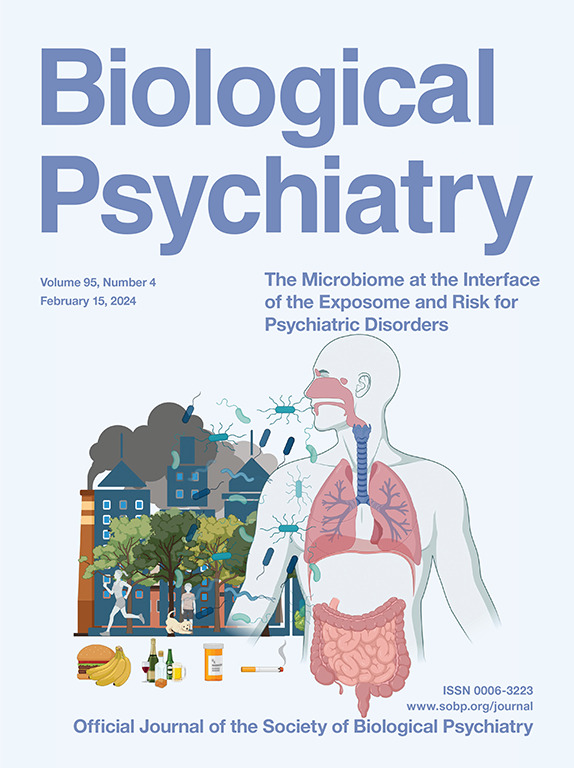Brain Network Localization of Gray Matter Atrophy and Neurocognitive and Social Cognitive Dysfunction in Schizophrenia
IF 9.6
1区 医学
Q1 NEUROSCIENCES
引用次数: 0
Abstract
Background
Numerous studies have established the presence of gray matter atrophy and brain activation abnormalities during neurocognitive and social cognitive tasks in schizophrenia. Despite a growing consensus that diseases localize better to distributed brain networks than individual anatomical regions, relatively few studies have examined brain network localization of gray matter atrophy and neurocognitive and social cognitive dysfunction in schizophrenia.
Methods
To address this gap, we initially identified brain locations of structural and functional abnormalities in schizophrenia from 301 published neuroimaging studies with 8712 individuals with schizophrenia and 9275 healthy control participants. By applying novel functional connectivity network mapping to large-scale resting-state functional magnetic resonance imaging datasets, we mapped these affected brain locations to 3 brain abnormality networks of schizophrenia.
Results
The gray matter atrophy network of schizophrenia comprised a broadly distributed set of brain areas predominantly implicating the ventral attention, somatomotor, and default networks. The neurocognitive dysfunction network was also composed of widespread brain areas primarily involving the frontoparietal and default networks. By contrast, the social cognitive dysfunction network consisted of circumscribed brain regions mainly implicating the default, subcortical, and visual networks.
Conclusions
Our findings suggest shared and unique brain network substrates of gray matter atrophy and neurocognitive and social cognitive dysfunction in schizophrenia, which may not only refine the understanding of disease neuropathology from a network perspective but may also contribute to more targeted and effective treatments for impairments in different cognitive domains in schizophrenia.
精神分裂症患者灰质萎缩、神经认知和社会认知功能障碍的脑网络定位。
研究背景大量研究证实,精神分裂症患者在神经认知和社会认知任务中存在灰质萎缩和脑激活异常。尽管越来越多的人认为,与单个解剖区域相比,疾病在分布式脑网络中的定位效果更好,但目前仍缺乏研究精神分裂症患者灰质萎缩、神经认知和社会认知功能障碍的脑网络定位的文献:为了填补这一空白,我们从已发表的301项神经影像学研究中初步确定了精神分裂症患者大脑结构和功能异常的位置,研究对象包括8712名精神分裂症患者和9275名健康对照者。通过对大规模静息态功能磁共振成像数据集应用新型功能连接网络映射,我们将这些受影响的大脑位置映射到精神分裂症的3个大脑异常网络中:结果:精神分裂症的灰质萎缩网络由一组广泛分布的脑区组成,主要涉及腹侧注意网络、躯体运动网络和默认网络。神经认知功能障碍网络也由广泛分布的脑区组成,主要涉及额顶和缺省网络。与此相反,社会认知功能障碍网络由限定的脑区组成,主要涉及默认网络、皮层下网络和视觉网络:我们的研究结果表明,精神分裂症患者的灰质萎缩、神经认知和社会认知功能障碍具有共同和独特的脑网络基底,这不仅可以从网络的角度完善对疾病神经病理学的理解,还可能有助于对精神分裂症患者不同认知领域的障碍进行更有针对性和更有效的治疗。
本文章由计算机程序翻译,如有差异,请以英文原文为准。
求助全文
约1分钟内获得全文
求助全文
来源期刊

Biological Psychiatry
医学-精神病学
CiteScore
18.80
自引率
2.80%
发文量
1398
审稿时长
33 days
期刊介绍:
Biological Psychiatry is an official journal of the Society of Biological Psychiatry and was established in 1969. It is the first journal in the Biological Psychiatry family, which also includes Biological Psychiatry: Cognitive Neuroscience and Neuroimaging and Biological Psychiatry: Global Open Science. The Society's main goal is to promote excellence in scientific research and education in the fields related to the nature, causes, mechanisms, and treatments of disorders pertaining to thought, emotion, and behavior. To fulfill this mission, Biological Psychiatry publishes peer-reviewed, rapid-publication articles that present new findings from original basic, translational, and clinical mechanistic research, ultimately advancing our understanding of psychiatric disorders and their treatment. The journal also encourages the submission of reviews and commentaries on current research and topics of interest.
 求助内容:
求助内容: 应助结果提醒方式:
应助结果提醒方式:


